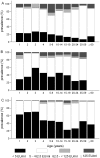Increased population prevalence of low pertussis toxin antibody levels in young children preceding a record pertussis epidemic in Australia
- PMID: 22558249
- PMCID: PMC3338806
- DOI: 10.1371/journal.pone.0035874
Increased population prevalence of low pertussis toxin antibody levels in young children preceding a record pertussis epidemic in Australia
Abstract
Background: Cross-sectional serosurveys using IgG antibody to pertussis toxin (IgG-PT) are increasingly being used to estimate trends in recent infection independent of reporting biases.
Methods/principal findings: We compared the age-specific seroprevalence of various levels of IgG-PT in cross-sectional surveys using systematic collections of residual sera from Australian diagnostic laboratories in 1997/8, 2002 and 2007 with reference to both changes in the pertussis vaccine schedule and the epidemic cycle, as measured by disease notifications. A progressive decline in high-level (≥62.5 EU/ml) IgG-PT prevalence from 19% (95% CI 16-22%) in 1997/98 to 12% (95% CI 11-14%) in 2002 and 5% (95% CI 4-6%) in 2007 was consistent with patterns of pertussis notifications in the year prior to each collection. Concomitantly, the overall prevalence of undetectable (<5 EU/ml) levels increased from 17% (95% CI 14-20%) in 1997/98 to 38% (95% CI 36-40%) in 2007 but among children aged 1-4 years, from 25% (95% CI 17-34%) in 1997/98 to 62% (95% CI 56-68%) in 2007. This change followed withdrawal of the 18-month booster dose in 2003 and preceded record pertussis notifications from 2008 onwards.
Conclusions/significance: Population seroprevalence of high levels of IgG-PT is accepted as a reliable indicator of pertussis disease activity over time within and between countries with varying diagnostic practices, especially in unimmunised age groups. Our novel findings suggest that increased prevalence of undetectable IgG-PT is an indicator of waning immunity useful for population level monitoring following introduction of acellular vaccines and/or schedule changes.
Conflict of interest statement
Figures



References
-
- Crowcroft NS, Pebody RG. Recent developments in pertussis. Lancet. 2006;367:1926–1936. - PubMed
-
- World Health Organization. Immunization, Vaccines and Biologicals. 2010. Pertussis. Available: http://www.who.int/immunization/topics/pertussis/en/index.html#. Accessed 2011 Jan 24.
-
- Guiso N, Wirsing Von König CH, Forsyth K, Tan T, Plotkin SA. The Global Pertussis Initiative: report from a round table meeting to discuss the epidemiology and detection of pertussis, Paris, France, 11–12 January 2010. Vaccine. 2011;29:1115–1121. doi: 10.1016/j.vaccine.2010.12.010. - DOI - PubMed
-
- Andrews R, Herceg A, Roberts C. Pertussis notifications in Australia, 1991 to 1997. Commun Dis Intell. 1997;21:145–148. - PubMed
Publication types
MeSH terms
Substances
LinkOut - more resources
Full Text Sources
Medical

